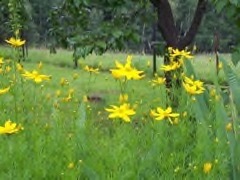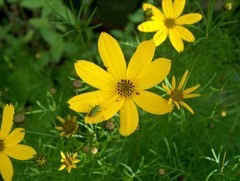 |
|
Darwinek wikimedia.org |
 |
| Anneli Salo wikimedia.org |
Translate this page:
Summary
Physical Characteristics

 Coreopsis verticillata is a PERENNIAL growing to 1 m (3ft 3in) by 1 m (3ft 3in) at a fast rate.
Coreopsis verticillata is a PERENNIAL growing to 1 m (3ft 3in) by 1 m (3ft 3in) at a fast rate.
See above for USDA hardiness. It is hardy to UK zone 4.
Suitable for: light (sandy) and medium (loamy) soils, prefers well-drained soil and can grow in nutritionally poor soil. Suitable pH: mildly acid and neutral soils. It cannot grow in the shade. It prefers dry or moist soil and can tolerate drought.
UK Hardiness Map
US Hardiness Map
Synonyms
C. verticillata var. verticillata
Plant Habitats
Edible Uses
Edible Parts: Flowers
Edible Uses:
Edible flowers [318-1].
References More on Edible Uses
Medicinal Uses
Plants For A Future can not take any responsibility for any adverse effects from the use of plants. Always seek advice from a professional before using a plant medicinally.
Diuretic
Diuretic [318-1].
References More on Medicinal Uses
The Bookshop: Edible Plant Books
Our Latest books on Perennial Plants For Food Forests and Permaculture Gardens in paperback or digital formats.

Edible Tropical Plants
Food Forest Plants for Hotter Conditions: 250+ Plants For Tropical Food Forests & Permaculture Gardens.
More

Edible Temperate Plants
Plants for Your Food Forest: 500 Plants for Temperate Food Forests & Permaculture Gardens.
More

More Books
PFAF have eight books available in paperback and digital formats. Browse the shop for more information.
Shop Now
Other Uses
Soil stabilization
Groundcover. A good medium to high density fast growing groundcover [1-2]. Erosion Control. Ornamental: Good in flower beds, borders, mass plantings, entrace ways, foundations, raised planters, and naturalized sunny areas. A good plant for areas with poor, dry soils. Container Garden. Cut Flower. Insectory:Long flowering period attracts butterflies. [318-1].
Special Uses
Attracts Wildlife Food Forest Ground Cover
References More on Other Uses
Cultivation details
A hardy herbaceous rhizomatous perennial. It can tolerate drought, poor soil, extreme heat, and neglect. Life Span: Short-Lived Perennial. Stand Persistence: Long. Form: Clump. Texture: Fine. Sun: Full Sun. Soil Type: Sandy, Loamy, Silty. Soil Moisture: Moderate, Dry. Soil pH: 6.5 - 7.5. Root Type: Rhizome. Seasonal Interest: Summer-Fall. Notes: Spreads via rhizome, forms a dense clump. Seeds resemble ticks, hence the name. Cultivars available. The following notable cultivars have all gained the Royal Horticultural Society's Award of Garden Merit: 'Grandiflora' - taller than other cultivars, with slightly larger flowers. 'Moonbeam' - pale, sulphur-yellow flowers, slightly shorter growth. 'Zagreb' - shorter than the species, bright yellow flowers. Flower Color: Yellow. Drought: Tolerant. Flood: Sensitive. Cold Injury: Infrequent. Wind Storm Damage: Infrequent. Disease Issues: Minor. Insect/Pest Damage: Minor. Animal Damage: Deer. Bloom Time: Summer - Late Fall. Fruit Time: Summer - Fall [318-1]. Tends to sprawl, particularly if grown in moist and/or fertile soils. Crown rot may occur if grown in moist, poorly drained soils. Plants may be sheared in mid to late summer to promote a fall rebloom and to remove any sprawling or unkempt foliage. Species plants can spread somewhat aggressively in the garden by both rhizomes and self-seeding [368-1]. For polyculture design as well as the above-ground architecture (form - tree, shrub etc. and size shown above) information on the habit and root pattern is also useful and given here if available. The plant growth habit is a clumper with limited spread [1-2]. The root pattern is fibrous dividing into a large number of fine roots [1-2]. The root pattern is stoloniferous rooting from creeping stems above the ground [1-2].
References Carbon Farming Information and Carbon Sequestration Information
Temperature Converter
Type a value in the Celsius field to convert the value to Fahrenheit:
Fahrenheit:
The PFAF Bookshop
Plants For A Future have a number of books available in paperback and digital form. Book titles include Edible Plants, Edible Perennials, Edible Trees,Edible Shrubs, Woodland Gardening, and Temperate Food Forest Plants. Our new book is Food Forest Plants For Hotter Conditions (Tropical and Sub-Tropical).
Shop Now
Plant Propagation
Propagation is by seed or division of the rhizomes.
Other Names
If available other names are mentioned here
Whorled tickseed, Whorled coreopsis, Thread-leaved tickseed, Thread leaf coreopsis, and Pot-of-gold.
Native Range
NORTHERN AMERICA: United States, West Virginia, Georgia (n.?), Maryland, Mississippi, North Carolina, South Carolina, Virginia, District of Columbia,
Weed Potential
Right plant wrong place. We are currently updating this section.
Please note that a plant may be invasive in one area but may not in your area so it's worth checking.
Species plants can spread somewhat aggressively in the garden by both rhizomes and self-seeding [368-1].
Conservation Status
IUCN Red List of Threatened Plants Status :

Growth: S = slow M = medium F = fast. Soil: L = light (sandy) M = medium H = heavy (clay). pH: A = acid N = neutral B = basic (alkaline). Shade: F = full shade S = semi-shade N = no shade. Moisture: D = dry M = Moist We = wet Wa = water.
Now available:
Food Forest Plants for Mediterranean Conditions
350+ Perennial Plants For Mediterranean and Drier Food Forests and Permaculture Gardens.
[Paperback and eBook]
This is the third in Plants For A Future's series of plant guides for food forests tailored to
specific climate zones. Following volumes on temperate and tropical ecosystems, this book focuses
on species suited to Mediterranean conditions—regions with hot, dry summers and cool, wet winters,
often facing the added challenge of climate change.
Read More
Expert comment
Author
L.
Botanical References
Links / References
For a list of references used on this page please go here
Readers comment
| Add a comment |
|
If you have important information about this plant that may help other users please add a comment or link below. Only comments or links that are felt to be directly relevant to a plant will be included. If you think a comment/link or information contained on this page is inaccurate or misleading we would welcome your feedback at [email protected]. If you have questions about a plant please use the Forum on this website as we do not have the resources to answer questions ourselves.
* Please note: the comments by website users are not necessarily those held by PFAF and may give misleading or inaccurate information.
To leave a comment please Register or login here All comments need to be approved so will not appear immediately.
|
Subject : Coreopsis verticillata
|
|
|
|